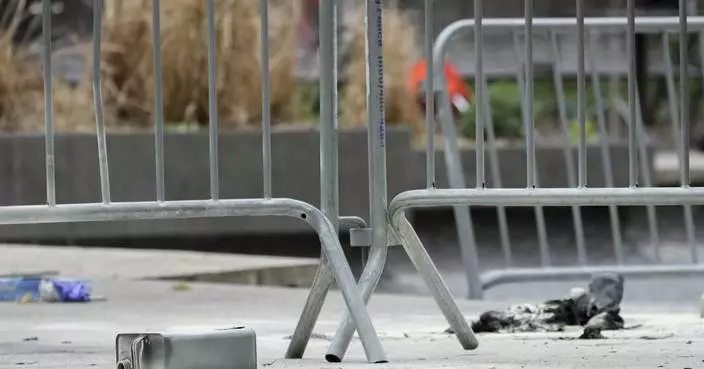A protest against U.S. immigration policy forced the evacuation of the Statue of Liberty on the Fourth of July, with a group unfurling a banner from the pedestal and a woman holding police at bay for hours after she climbed the base and sat by the statue's robes.
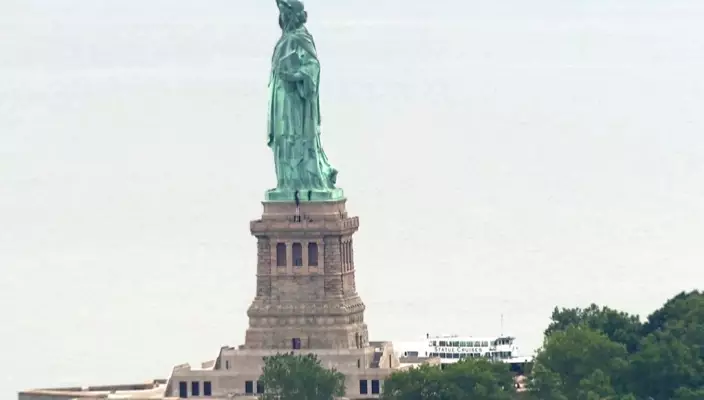
In this image taken from video, people climb on the pedestal of the Statue of Liberty in New York Harbor Wednesday, July 4, 2018. (AP Photo)
The woman and at least a half-dozen demonstrators who displayed the banner were arrested, while the climb forced thousands of visitors to leave the iconic American symbol on the nation's birthday.
About 100 feet (30 meters) aboveground, the woman engaged in a four-hour standoff with police before two officers climbed up to the base and went over to her. With the dramatic scene unfolding on live television, she and the officers edged carefully around the statue toward a ladder, and she climbed down about 25 feet (8 meters) to the monument's observation point and was taken into custody.
The woman, Therese Okoumou, told police she was protesting the separation of immigrant children from parents who cross the U.S.-Mexico border illegally, according to a federal official who was briefed on what happened but wasn't authorized to discuss it and spoke on the condition of anonymity. A message left at a possible phone number for Okoumou wasn't immediately returned.

**HFR WEDNESDAY, JULY 4**FILE--In this Jan. 21, 2018, file photo, the Statue of Liberty is shown in New York. A judge has ordered the U.S. (AP Photo/Mark Lennihan, file)
The climber was among about 40 demonstrators who earlier unfurled a banner calling for abolishing the federal government's chief immigration enforcement agency, said Jay W. Walker, an organizer with Rise and Resist, which arranged the demonstration.
Walker said the other demonstrators had no idea the woman would make the ascent, which wasn't part of the planned protest.
"We don't know whether she had this planned before she ever got to Liberty Island or whether it was a spur-of-the-moment decision," Walker said.
Regardless, he said he felt the publicity would help the group's cause.
A spokesman for the National Park Service, which runs the monument, saw it differently.
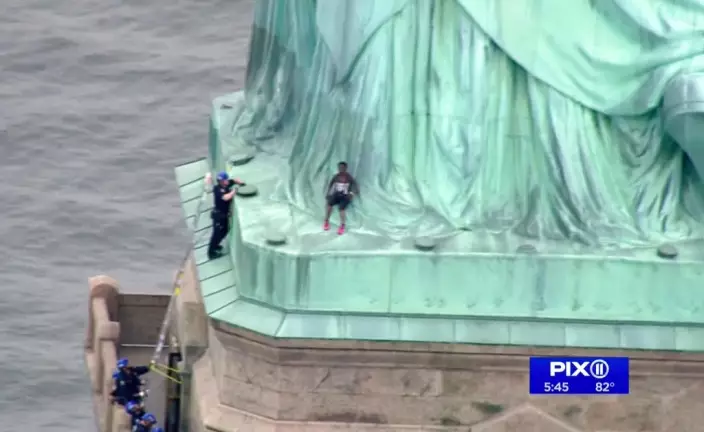
In this image made from video by PIX11, a person, center, leans against the robes of the Statue of Liberty on Liberty Island, as one of the police officers climbed up on a ladder to stand on a ledge nearby talking the climber into descending in New York, Wednesday, July 4, 2018. (PIX11 via AP)
"I feel really sorry for those visitors today" who had to leave or couldn't come, spokesman Jerry Willis said. "People have the right to speak out. I don't think they have the right to co-opt the Statue of Liberty to do it."
The climber ascended from the observation point, Willis said. Visitors were forced to leave Liberty Island hours before its normal 6:15 p.m. closing time, he said.
Earlier and farther below, at least six people were taken into custody after unfurling a banner that read "Abolish I.C.E.," referring to U.S. Immigration and Customs Enforcement, whose officers arrest and deport immigrants who are in the U.S. illegally, among other duties.
Willis said federal regulations prohibit hanging banners from the monument.
Rise and Resist opposes President Donald Trump's administration and advocates ending deportations and family separations at the border.
U.S. Attorney General Jeff Sessions has said the president's immigration policy is a step forward for public safety.
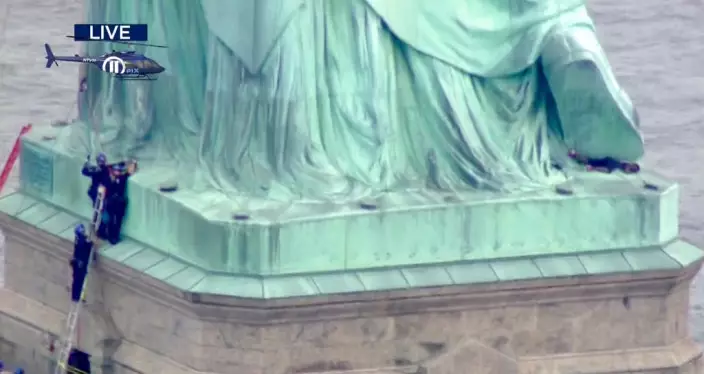
In this image made from television news video by PIX11, a person, right, lies under the right foot of New York's Statue of Liberty as police officers, left, work to convince the climber to descend, Wednesday, July 4, 2018. (PIX11 via AP)
Under Trump's zero-tolerance policy, the government has begun requiring border agents to arrest and prosecute anyone caught entering the country illegally. That resulted in more than 2,000 children being separated from their parents within six weeks this spring.
Under public pressure, Trump later halted his policy of taking children from their detained parents. A federal judge in California ordered the Trump administration late last month to reunite the more than 2,000 children with their parents in 30 days.
"Abolish ICE" has become a rallying cry at protests around the country and for some Democratic officeholders seeking to boost their progressive credentials. But Trump, a Republican, said on Twitter last week that abolishing ICE will "never happen!"
The Statue of Liberty has long been a welcoming symbol for immigrants and refugees coming to the U.S. It also has been a setting for protests and other actions that forced evacuations.
Last February, someone hung a banner reading "Refugees Welcome" from the observation deck. The sign was taken down about an hour after being discovered.
A year earlier, a West Virginia man was sentenced to time served after calling in a bomb threat that forced the evacuation of Liberty Island, sending 3,200 people on boats back to lower Manhattan and New Jersey.
In 2000, 12 people protesting the Navy's use of the Puerto Rican Island of Vieques for bombing exercises were arrested after a man climbed out on the spires of the statue's crown and attached flags and banners to it.
NEW YORK (AP) — Months before they pitched their tents on Columbia University's main lawn, inspiring a wave of protest encampments at college campuses nationwide, a small group of pro-Palestinian student activists met privately to sketch out the logistical details of a round-the-clock occupation.
In hours of planning sessions, they discussed communications strategies and their willingness to risk arrest, along with the more prosaic questions of bathroom access and trash removal. Then, after scouring online retailers and Craigslist for the most affordable options, they ordered the tents.
“There’s been a lot of work, a lot of meetings that went into it, and when we finally pulled it off, we had no idea how it would go,” said Columbia graduate student Elea Sun. “I don’t think anyone imagined it would take off like it did.”
Those involved with the Columbia protest, also known as the “Gaza Solidarity Encampment,” describe their organizing efforts as both meticulously planned and heavily improvised. They say the university’s heavy-handed attempts to quell the movement have only lent it more momentum.
Basil Rodriguez, a Columbia student affiliated with Students for Justice in Palestine, a group the university suspended in November, said organizers had been in touch with students at other schools about how to erect their own encampments. About 200 people joined one call with students on other campuses.
To attract the most news media attention, the organizers timed the Columbia encampment to coincide with university president Minouche Shafik's testimony last Wednesday to a congressional panel investigating concerns about antisemitism at elite colleges.
The following day, officers with the New York police department flooded the campus, dismantled the tents, arrested more than 100 activists, and threw out their food and water. Shafik said she had taken the “extraordinary step” of requesting police intervention because the encampment had disrupted campus life and created a “harassing and intimidating environment" for many students.
That decision fueled currents of rage that quickly washed across the country, prompting students at other college campuses to set up their own protest encampments.
“We’re standing here today because we’re inspired by the students at Columbia, who we consider to be the heart of the student movement,” Malak Afaneh, a law student and spokesperson for the 100-student-strong encampment at the University of California, Berkeley, said Tuesday.
Just hours after last week's arrests, some Columbia students jumped a fence to an adjacent lawn, wrapping themselves in blankets until a new provision of tents eventually arrived. In the week since police cleared the first encampment, the second iteration has grown not only larger, but more organized.
“The university thought they could call the police and make the protesters go away. Now we have twice as many protesters,” said Joseph Howley, an associate professor at Columbia and supporter of the encampment. “The students have experienced a ratcheting up of repression that has prompted them to escalate with their own tactics now.”
The mood was lively and upbeat on Wednesday, as some students passed out matzo leftover from a Passover seder and knafeh, a flaky Middle Eastern pastry dropped off by a supportive Palestinian family from New Jersey.
Others attended a teach-in delivered by a Columbia alumnus involved in the anti-apartheid movement in the 1980s, pulled books off the shelf of a “People’s Library,” and helped themselves to art supplies from a craft table. Those who’d spent the night in one of roughly 80 tents said they used the bathrooms at nearby university buildings. (An earlier experiment with a “camp toilet” had been quickly abandoned.)
At the nearby law library, a group of negotiators representing the protesters has been meeting intermittently with university administrators since Friday to discuss their demands, which include cutting financial ties with Israel and the companies involved in the war in Gaza, as well as amnesty for students and staff facing discipline for participating in the protests.
Those talks broke down on Tuesday night, according to the lead negotiator, Mahmoud Khalil, after he said the university threatened to send in police and the National Guard if the encampment wasn’t gone by midnight. Hundreds of students and faculty quickly packed onto the lawn in the largest numbers since the start of the demonstration.
Overnight, the university backtracked, giving demonstrators a 48-hour extension if the group agreed to block nonstudents from the encampment and remove a certain number of tents. A spokesperson later denied that the university had suggested calling the National Guard.
While there have been confrontations and allegations of antisemitic activity outside the university’s gates, police described students inside the encampment as peaceful and compliant.
Organizers said they’d dismantled a few tents for fire safety reasons, but were still admitting outsiders to the encampment as long as they abided by community guidelines, including: no photographs, littering or engaging with counter-protesters. They said they had no plans to leave until their demands were met.
Opponents of the encampment say it has destabilized campus life, forcing the university to barricade many of its entrances to nonstudents while putting Jewish students in harm’s way.
Omer Lubaton Granot, a graduate student from Israel who is studying for a master's degree in public administration at Columbia, said the university should have taken “more assertive action” in clearing the encampment. He accused protesters of embracing an aggressive anti-Zionist stance that made him feel unsafe.
“They’re canceling my identity and they’re threatening me as an Israeli and as a Jew,” he said.
Officials including President Joe Biden and Democratic New York Gov. Kathy Hochul have also condemned what they described as antisemitism associated with the protests. On Wednesday, Republican House Speaker Mike Johnson held a news conference at Columbia to denounce the encampment, drawing jeers from many students.
Mayor Eric Adams, a Democrat, noted this week that many of the students were sleeping in the same brand of tents, which he said could indicate that “outside agitators” were responsible for arranging the encampment, a baseless claim that had earlier spread among some right-leaning news media outlets and New York police officials.
Layla Saliba, a Palestinian American student at Barnard, Columbia's sister college that shares some facilities with the university, dismissed the idea. She said the students leading the protest were mostly “nerds” who enjoyed lengthy meetings and consensus building.
“To imply this is AstroTurfed or paid off, when it has actually been students laying the groundwork for this from the very beginning, is ridiculous,” she said.
As for the similarity of the tents, she said the brand had been ordered in bulk by student organizers. As the encampment has expanded, students have brought their own camping gear, she said, pointing to the varied sleeping arrangements on the bustling lawn.
“There’s apparently a lot of people here at Columbia who like to camp,” she added. “I’ll admit I was a bit surprised by that.”
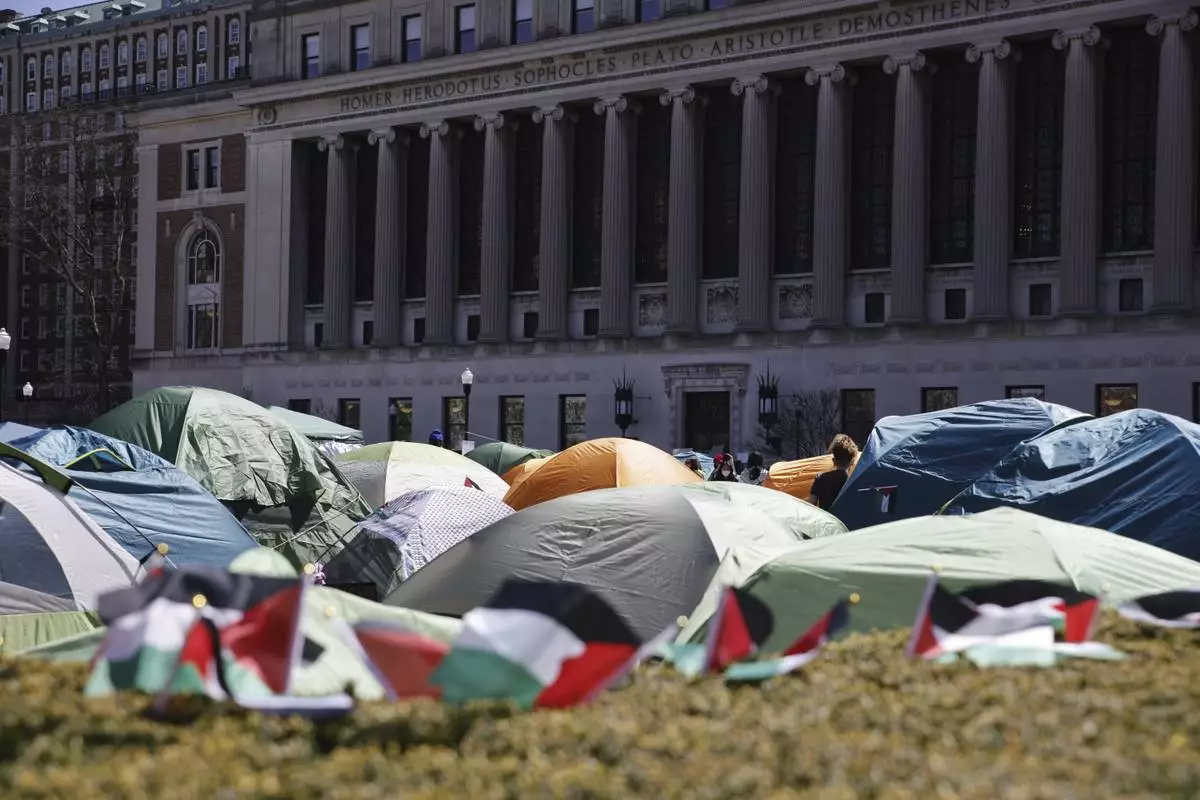
Tents are erected at a pro-Palestinian demonstration encampment at Columbia University in New York, Monday April 22, 2024. (AP Photo/Stefan Jeremiah)
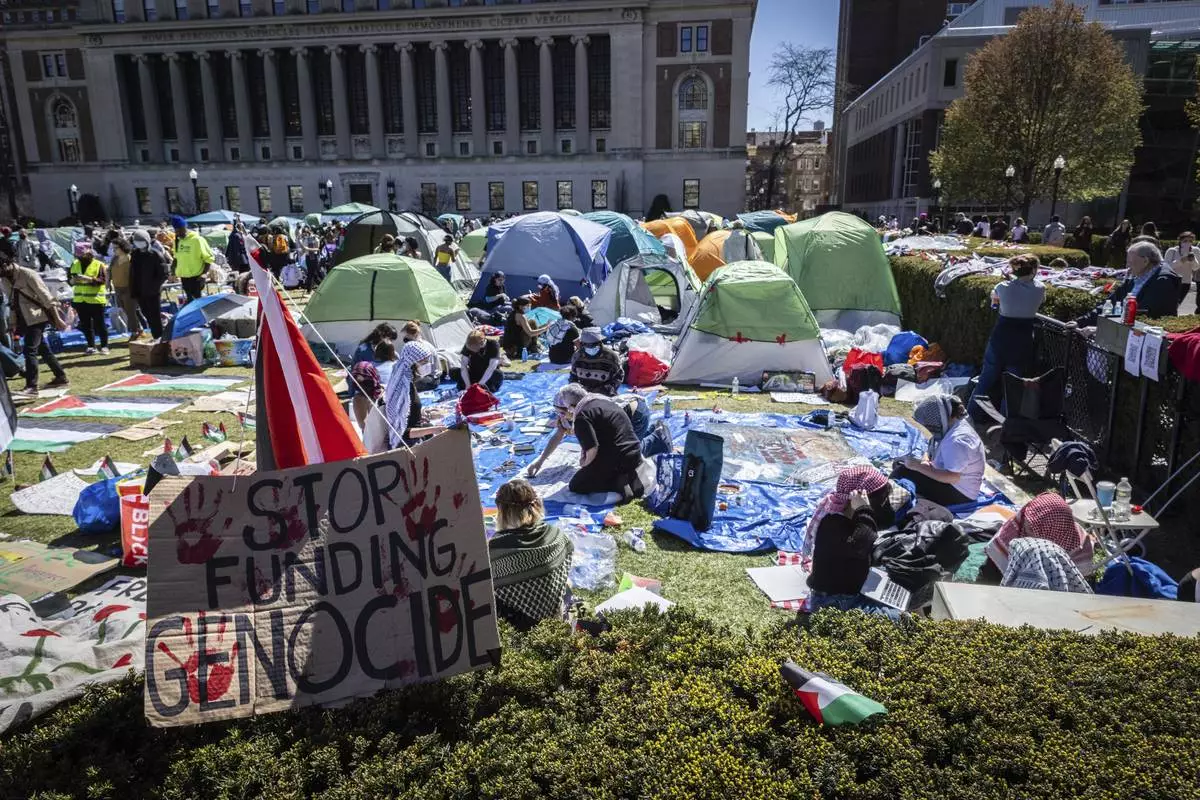
A sign sits erected at the pro-Palestinian demonstration encampment at Columbia University in New York, Monday, April 22, 2024. (AP Photo/Stefan Jeremiah)
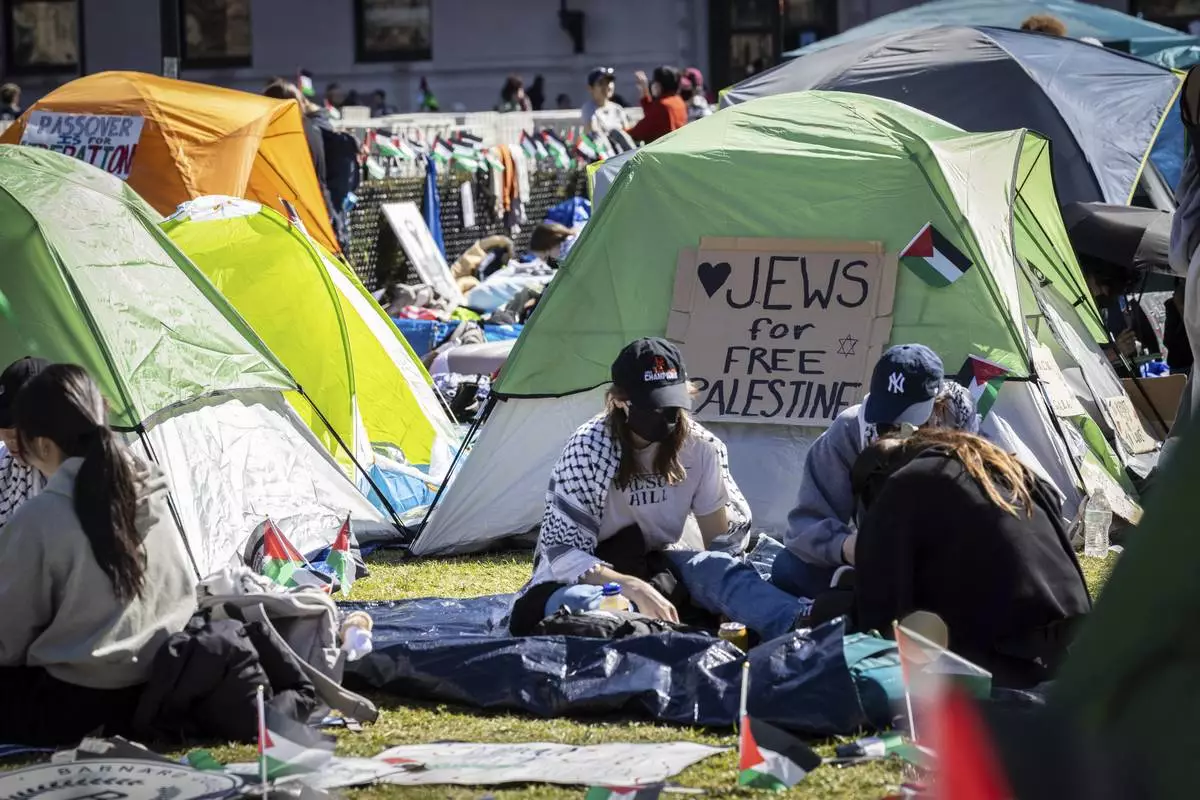
Student protesters sit in front of a tent during the Pro-Palestinian protest at the Columbia University campus in New York, Monday April 22, 2024. (AP Photo/Stefan Jeremiah)
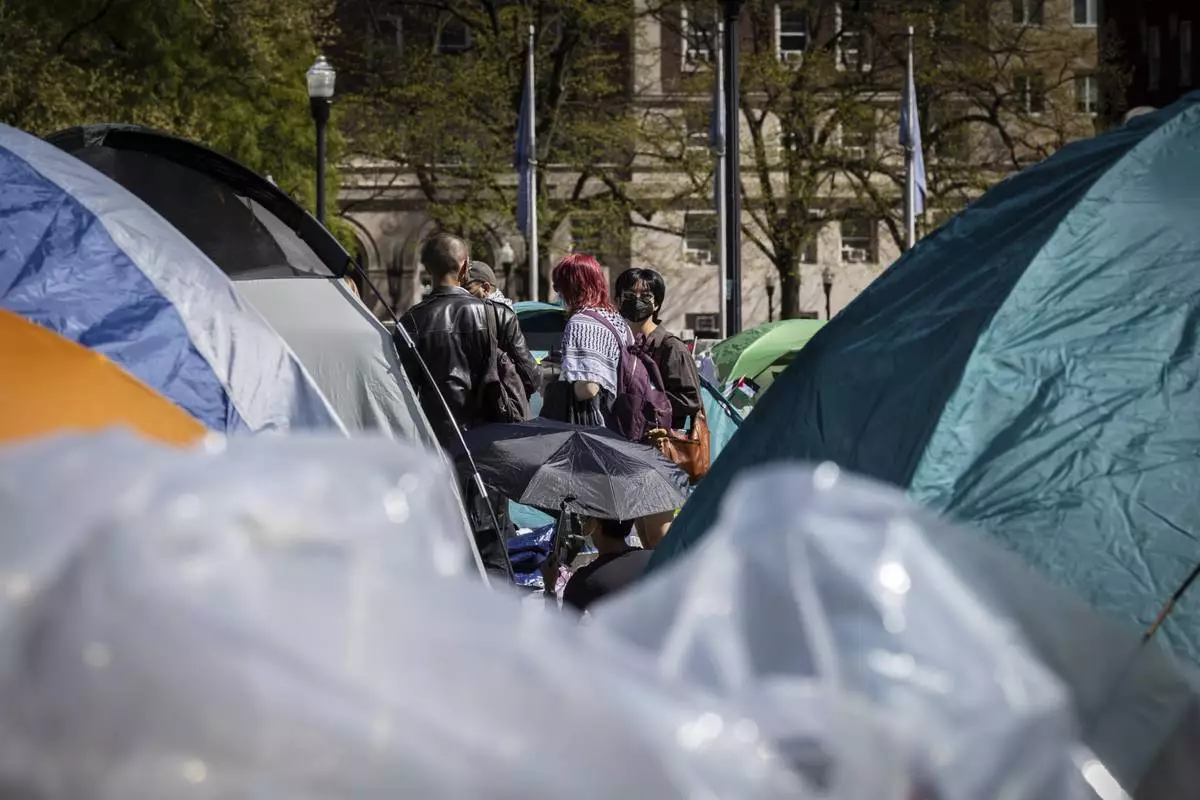
A student protester sits among the tents erected at the Pro-Palestinians protest at the Columbia University campus in New York on Monday April 22, 2024. (AP Photo/Stefan Jeremiah)
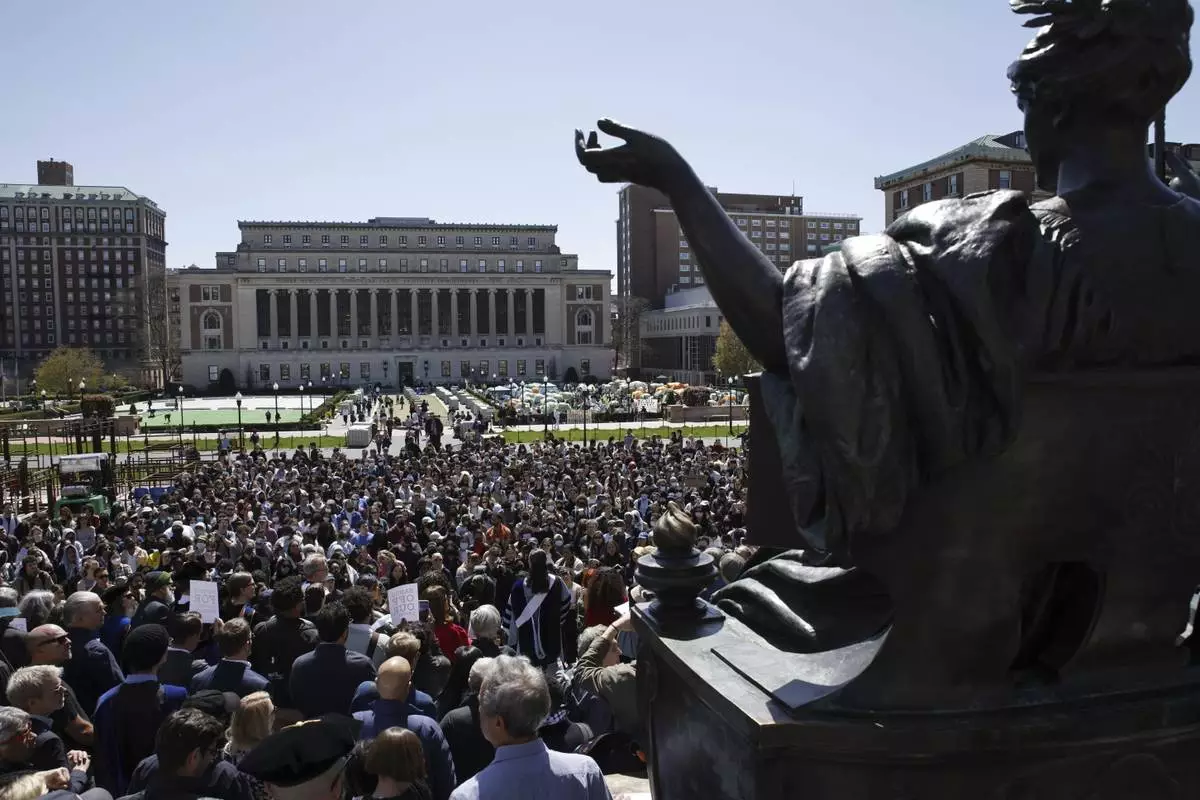
Columbia University professors speak in solidarity with their students rights to protest free from arrest at the Columbia University campus in New York on Monday April 22, 2024. (AP Photo/Stefan Jeremiah)

A sign that reads, Gaza Solidarity Encampment, is seen during the Pro-Palestinians protest at the Columbia University campus in New York, Monday April 22, 2024. (AP Photo/Stefan Jeremiah)


















